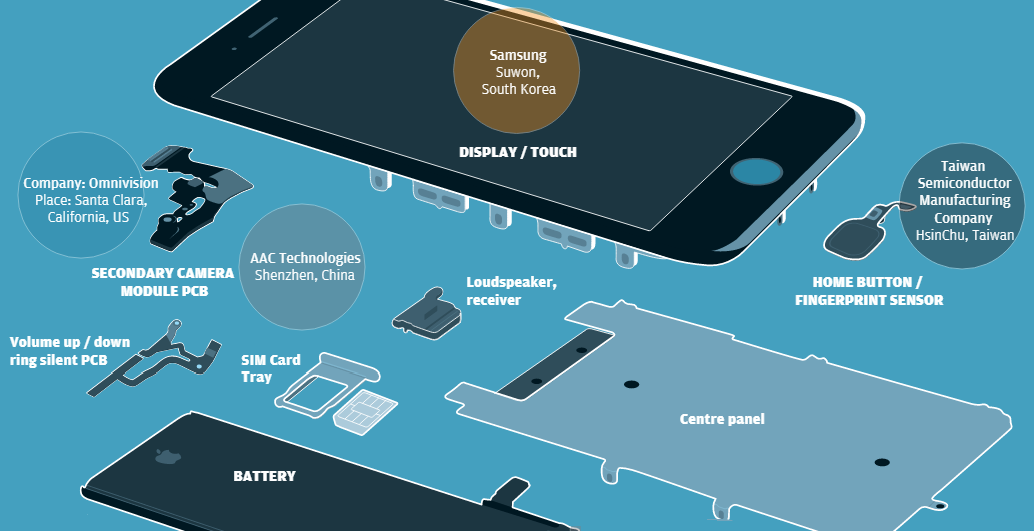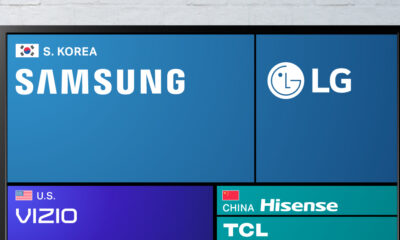Technology
See Every Single Part Inside an iPhone

See Every Single Part Inside an iPhone
In the past, we’ve broken down the extraordinary raw materials in an iPhone 6s, but today’s infographic takes it a step further: it delves into each individual component inside an iPhone as well as where it comes from.
Unfortunately, the data is not for the latest and greatest iPhone 7, which was only introduced last week. That said, it is still interesting to dive into the components and the manufacturers that make the 6s work.
What’s inside an iPhone?
The infographic comes to us from SCMP, and in total it highlights 34 individual components in an iPhone 6s. These parts range from German accelerometers to camera modules from Sony in Japan. Parts come from a range of eight countries, which include the United States, China, Taiwan, South Korea, Japan, Germany, the Netherlands, and the UK.
Many people will be likely surprised to learn that there are key pieces in the iPhone that come from Apple’s biggest competitor. At least some of the Apple A9 chips are manufactured by Samsung, but the South Korean company also produces display screens, mobile DRAM, and flash memory for Apple’s various devices. The ongoing relationship between the companies makes Apple the biggest external customer for Samsung’s components in the world.
Also interesting is that the manufacturing of physical pieces of bigger hardware (battery, screen, camera, etc.) tends to be dominated by Asian suppliers, while the technologies integrated with the printed circuit board mostly come from U.S. and European suppliers.
Technology for the iPhone 6s lithium-ion battery, for example, comes from three companies all in Asia. Two are based in China (Desay Battery Tech, and Sunwoda Electronics), while the other is located in Taiwan (Simple Technology).
Meanwhile, the following technologies from Texas Instruments in the United States integrate right into the printed circuit board: battery charger, power management, and the LED backlight Retina display driver. For another example, Bosch Sensortec out of Germany also provides two parts built into the circuit board: a barometer and an accelerometer.
Brands
How Tech Logos Have Evolved Over Time
From complete overhauls to more subtle tweaks, these tech logos have had quite a journey. Featuring: Google, Apple, and more.

How Tech Logos Have Evolved Over Time
This was originally posted on our Voronoi app. Download the app for free on iOS or Android and discover incredible data-driven charts from a variety of trusted sources.
One would be hard-pressed to find a company that has never changed its logo. Granted, some brands—like Rolex, IBM, and Coca-Cola—tend to just have more minimalistic updates. But other companies undergo an entire identity change, thus necessitating a full overhaul.
In this graphic, we visualized the evolution of prominent tech companies’ logos over time. All of these brands ranked highly in a Q1 2024 YouGov study of America’s most famous tech brands. The logo changes are sourced from 1000logos.net.
How Many Times Has Google Changed Its Logo?
Google and Facebook share a 98% fame rating according to YouGov. But while Facebook’s rise was captured in The Social Network (2010), Google’s history tends to be a little less lionized in popular culture.
For example, Google was initially called “Backrub” because it analyzed “back links” to understand how important a website was. Since its founding, Google has undergone eight logo changes, finally settling on its current one in 2015.
| Company | Number of Logo Changes |
|---|---|
| 8 | |
| HP | 8 |
| Amazon | 6 |
| Microsoft | 6 |
| Samsung | 6 |
| Apple | 5* |
Note: *Includes color changes. Source: 1000Logos.net
Another fun origin story is Microsoft, which started off as Traf-O-Data, a traffic counter reading company that generated reports for traffic engineers. By 1975, the company was renamed. But it wasn’t until 2012 that Microsoft put the iconic Windows logo—still the most popular desktop operating system—alongside its name.
And then there’s Samsung, which started as a grocery trading store in 1938. Its pivot to electronics started in the 1970s with black and white television sets. For 55 years, the company kept some form of stars from its first logo, until 1993, when the iconic encircled blue Samsung logo debuted.
Finally, Apple’s first logo in 1976 featured Isaac Newton reading under a tree—moments before an apple fell on his head. Two years later, the iconic bitten apple logo would be designed at Steve Jobs’ behest, and it would take another two decades for it to go monochrome.
-

 Markets1 week ago
Markets1 week agoRanked: The Largest U.S. Corporations by Number of Employees
-

 Green3 weeks ago
Green3 weeks agoRanked: Top Countries by Total Forest Loss Since 2001
-

 Money2 weeks ago
Money2 weeks agoWhere Does One U.S. Tax Dollar Go?
-

 Automotive2 weeks ago
Automotive2 weeks agoAlmost Every EV Stock is Down After Q1 2024
-

 AI2 weeks ago
AI2 weeks agoThe Stock Performance of U.S. Chipmakers So Far in 2024
-

 Markets2 weeks ago
Markets2 weeks agoCharted: Big Four Market Share by S&P 500 Audits
-

 Real Estate2 weeks ago
Real Estate2 weeks agoRanked: The Most Valuable Housing Markets in America
-

 Money2 weeks ago
Money2 weeks agoWhich States Have the Highest Minimum Wage in America?













